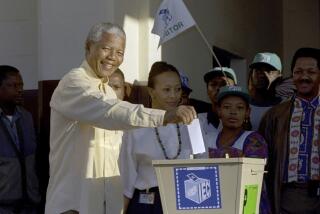Accord Separates Pretoria’s Forces and Cubans in Region : S. Africa Completes Troop Withdrawal From Angola
- Share via
CALAI, Angola — Shortly after noon Tuesday, on a golden-dry African plain, a South African convoy of tanks and anti-aircraft guns rumbled across a narrow bridge into Namibia, completing the withdrawal of Pretoria’s troops from war-torn Angola.
“No Retreat. No Surrender,” boasted a slogan chalked in white on a tank from a unit of up to 1,000 soldiers that had been stationed 180 miles inside Angola.
Awaiting the soldiers as they crossed the Kavango River into Rundu, Namibia, was a large white sign stretched across the road. It read: “Welcome Winners” and, in Afrikaans, the first language of most white South Africans, “Welkom Wenners.”
“These men have been involved in a very important operation, and we have achieved our aims,” said Lt. General Ian Gleeson, chief of staff for the South African Defense Force. Those accomplishments included keeping Angola-based Namibian guerrillas as well as Cuban troops at bay, he said.
“We are ready for the next phase” of the peace process, Gleeson added.
The pullout of an estimated 2,500 South African soldiers from Angola, the third South African withdrawal from Angola in 13 years of war, began after a cease-fire was declared two weeks ago. A treaty establishes a buffer zone in southern Angola where neither Cuban nor South African soldiers may go.
Angola, Cuba and South Africa have been participating in U.S.-mediated talks aimed at ending the Angolan civil war, removing Cuba’s 50,000 troops from Angola and granting independence to Namibia, the South Africa-administered territory that shares borders with South Africa and Angola.
Although Tuesday’s withdrawal marked an important step in that peace process, a major hurdle remains--agreement on a timetable for Cuban soldiers to leave Angola, where they have been supporting the Marxist government since Portuguese colonial rule ended in 1975.
Without agreement on a Cuban withdrawal, Pretoria has refused to begin implementing the 10-year-old U.N. plan for Namibia, which calls for free and fair elections and a pullout of South Africa’s 50,000 troops stationed there.
To Monitor Truce
Minutes after the last South African vehicle left Angola on Tuesday, members of the new Joint Military Monitoring Committee walked across the 100-yard-long bridge near this border town. The panel, made up of military officers from all three forces, will begin monitoring the cease-fire treaty officially on Thursday.
“All the troops are out now. You can report to high command,” South African Col. Archie Moore told Cuban Col. Jesus Falcon as the two men stood on the Angolan side of the bridge. The Cuban said he could not say for sure, “but we hope that no South Africans are left on this side.”
“We have given our word,” responded Moore.
Angolan Maj. Osvaldo van Dunem said the South African withdrawal would “help us find the peace we are looking for. I hope by doing this we will be able to forget all the past, the war. Our peoples deserve peace.”
Then the three uniformed officers walked back into Namibia and South African soldiers began to dismantle the low-slung metal bridge, which was one of the two main points of departure for Pretoria’s Angola-based forces. A few hundred yards downstream, several villagers bathed naked in the cool river water.
Pretoria officials clearly considered their withdrawal, two days earlier than promised, a sign of good faith in the current peace talks in southern Africa.
In fact, the government flew a C-130 transport plane filled with journalists from Pretoria to witness the final stages of the withdrawal--and the two remaining convoys in Angola waited an hour to cross the bridge because the journalists’ plane was delayed.
At a briefing later in Pretoria, Glenn Babb, the deputy director general of foreign affairs for South Africa, took a tough line on Cuba’s presence in Angola.
“Cuba has been saying its troops are in Angola because South Africans are there,” Babb said. “Now there is not a single South African troop left in Angola. The Cubans no longer have that justification.”
The latest round of peace talks was suspended last week because of differences over the Cuban troop withdrawal. Babb said the offers made by Cuba and Angola were neither reasonable nor balanced, and he said that after the talks ended, the Cubans put their forces in Angola on high alert.
“That looks like a return to war, not peace,” Babb added. Another round of talks is due next week.
The treaty signed by the three countries last week calls for South Africa to stay off Angolan soil and for the Cubans to remain north of a line drawn across southern Angola, ranging 30 miles to 150 miles from the Angola-Namibia border.
In addition, the South-West Africa People’s Organization (SWAPO), which has been fighting a 22-year guerrilla war for Namibian independence, often from bases in southern Angola, agreed to remain north of the 16th Parallel, about 120 miles north of Namibia.
The National Union for the Total Independence of Angola (UNITA), backed by the United States and South Africa in its guerrilla war against the Angolan government, is not a party to the talks. But the group’s leader, Jonas Savimbi, has said he would ignore the cease-fire until the government in Luanda agrees to negotiate with him.
South Africa has staged complete troop withdrawals from Angola three times in the past decade. It originally stationed troops in southern Angola to ferret out SWAPO bases, from which attacks were launched into northern Namibia. But last year South Africa moved into Angola to help UNITA counter a government offensive.
More to Read
Sign up for Essential California
The most important California stories and recommendations in your inbox every morning.
You may occasionally receive promotional content from the Los Angeles Times.











